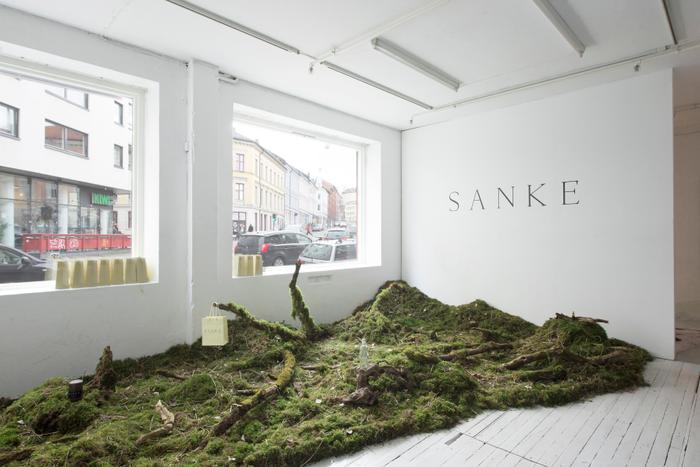The interactive essay “A Small Old Plot” by Andreas Ervik attempts to weave together a series of thoughts on green growing surfaces. It weaves together reflections on movies, video games and memes, as well as materialist philosophy and more-than-human phenomenology, infused with autoethnographic accounts of specific locations of lived experience and perspectives from an eco-oriented artistic practice. The essay does not seek to turn the reflections into a unified field, to be read from start to finish. It offers thoughts as a thicket, a deep surface intertwined with non-linear interconnectivity. The essay is a mood board of overgrown aesthetics, to be read in any direction.
Read Andreas Ervik’s interactive essay [here]

Image found on the website Know Your Meme, showing a combination of characters from The Legend of Zelda: Ocarina of Time with the background image of Windows XP
“Andreas’ essay charts out tensions between lawns – these domesticated, normative urban surfaces – and the deep, unruly surfaces created by the vegetation of thickets, moss and weed. One of the compelling aspects of his text is how he plants it upon different kinds of green surfaces, moving across them. This provides fertile ground on which the political stakes of these different surfaces’ formation and habitation come to light.”
“The playful and ‘strolling’ character of the text reminds me of what Andreas describes as the practice of ‘sanke’, the Norwegian word for ‘gathering’. He offers us a collection of green surfaces: lawns, images of lawns, plots of land, thoughts revolving around gardening, vegetation, moss, weed. However, his writing not only gathers fragments, but also overgrows and pollinates their understanding.”
“In a certain sense it has the feeling of a manifesto, as it proposes a need for ways of working against, or beyond, the lawn as a manifestation of patriarchy, capitalism and further types of human violence. ”
“Andreas’ essay opens up to the multitudes of ways to reflect upon surfaces as ambiguous political situations. This might be of relevance with relation to the form of the essay, as a reader might also be invited to repeat the reading of certain passages, through the weave like, non-linear character of its construction.”
“The human urge to control ‘the wild’ is so evident, yet rarely discussed. The text has many ideas and I like the manifold lines it follows; spectrums between maintenance/care and control/withdrawnness – gardening/ownership/leisure/work in relation to political stability or radicalization – accessibility; how thickets make you slow down and how open fields symbolizes efficiency and speed. Another path goes into the lawn as a gendered surface which I think takes on very important socio-ecological issues.”

SANKE exhibited in the show Tipping Points: Flourish and Collapse in the Circularity of the Geostory, curated by Angela Chan. Photo: Podium.
References
Aesthetics Wiki. n.d. Soft Apocalypse. https://aesthetics.fandom.com/wiki/Aesthetics_Wiki (Accessed 27 November 2022)
Albrecht, G., et al. 2013. Solastalgia: the distress caused by environmental change. Australas Psychiatry. 2007; 15 Suppl 1:S95-8.
anatfln. 2022. Twitter post, https://twitter.com/anatfln/status/1521151748370489344 (Accessed 11.12.22).
Chamovitz, Daniel. 2013. What a Plant Knows. A Field Guide to the Sense of Your Garden and Beyond. XX: Oneworld Publications.
Darwin, Charles. 1859/1985. The Origin of Species by Means of Natural Selection or the Preservation of Favoured Races in the Struggle for Life. London: Penguin Books.
DeLanda, Manuel. 1997/2000. A Thousand Years of Nonlinear History. New York: Swerve Editions.
Deleuze, Gilles, and Félix Guattari. 1987/2016. A Thousand Plateaus. Minneapolis: University of Minnesota Press.
Fukunaga, Cary Joji. 2014. True Detective. Season 1. Episode 3. “The Locked Room.” HBO.
Groover AT. 2005. What genes make a tree a tree? Trends Plant Sci. 2005 May; 10(5).
Heidegger, Martin. 1927/2008. Being and Time. XX: Harper Perennial Modern Thought.
Hester, Helen, and Nick Srnicek. 2021. “Shelter Against Communism”. e-flux December.
Hoch, E., D. Niemann, R. von Keller, et al. 2019. How effective and safe is medical cannabis as a treatment of mental disorders? A systematic review. Eur Arch Psychiatry Clin Neurosci 269, 87–105.
Ignatieva, Maria et al. 2015. Lawn as a cultural and ecological phenomenon: A conceptual framework for transdisciplinary research, Urban Forestry & Urban Greening, Volume 14, Issue 2.
Know Your Meme. n.d. Anti-lawn Memes. https://knowyourmeme.com/memes/anti-lawn-memes (Accessed 27 November 2022).
Know Your Meme. n.d. Windows XP. https://knowyourmeme.com/memes/windows-xp-bliss-wallpaper (Accessed 27 November 2022).
Krämer, Sybille. 2023. The Cultural Technique of Flattening. Metode Vol. 1 ‘Deep Surface.’
Lynch, David. 1986. Blue Velvet. De Laurentiis Entertainment Group.
Marder, Michael. 2016. Grafts. Writings on Plants. Minneapolis: University of Minnesota Press.
Marder, Michael. 2022. Trenches in Chernobyl. Aeon, https://aeon.co/essays/what-did-the-russians-dig-up-when-they-dug-trenches-in-chernobyl (Accessed 27 November 2022).
Margulis, Lynn, and Dorion Sagan. 2002. Acquiring Genomes. A Theory of the Origin of Species. New York: Basic Books.
Max Planck Society. 2012. Algae, lichens, and mosses take up huge amounts of carbon dioxide and nitrogen from atmosphere. Phys Org: https://phys.org/news/2012-06-algae-lichens-mosses-huge-amounts.html (Accessed 27 November 2022).
Morton, Timothy. 2004. Woodsworth Digs the Lawn. European Romantic Review, vol. 15, no. 2, pp. 317-327.
O’Brien K. 2022. Cannabidiol (CBD) in Cancer Management. 10; 14(4):885.
Oishi, Yoshitaka. 2022. Why are the aesthetics of modest mosses highly valued in Japanese gardens?. The Bryologist 125(1), 61-69.
Open-End-Ed. Are.na. n.d. https://www.are.na/open-end-ed/lawns-and-prairies (Accessed 11.12.22).
Ożarowski M, Karpiński TM, Zielińska A, Souto EB, Wielgus K. 2021. Cannabidiol in Neurological and Neoplastic Diseases: Latest Developments on the Molecular Mechanism of Action. Int J Mol Sci. 22(9):4294.
Roberts, Patrick. 2021. Jungle. How Tropical Forests Shaped World History. XX: Penguin Books.
Wilson, Edward O. 1986. Biophilia. The human bond with other species. XX: Harvard University Press.
Xu, Qiu-Fang, Chen-Fei Liang, Jun-Hui Chen, Yong-Chun Li, Hua Qin, Jeffry J. Fuhrmann. 2020. Rapid bamboo invasion (expansion) and its effects on biodiversity and soil processes +. Global Ecology and Conservation, Vol. 2.
Andreas Ervik, “A Small Old Plot,” Metode (2023), vol. 1 ‘Deep Surface’
